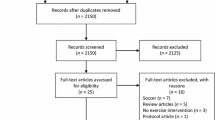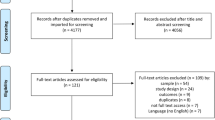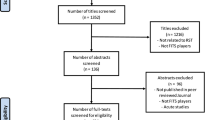Abstract
Background
Team ball sports such as soccer, basketball and volleyball have high participation levels worldwide. Musculoskeletal injuries are common in team ball sports and are associated with significant treatment costs, participation loss and long-term negative side effects. The results of recent randomized controlled trials provide support for the protective effect of injury-prevention exercise programmes (IPEPs) in team ball sports, but also highlight that achieving adequate compliance can be challenging. A key process in enhancing the ultimate impact of team ball sport IPEPs is identifying the specific implementation components that influence the adoption, execution and maintenance of these interventions. Despite this, no systematic review focussing on the specific implementation components of team ball sport IPEPs has been conducted.
Objectives
Our objective was to assess the reporting of specific implementation components in the published literature on team ball sport IPEPs using the Reach Efficacy Adoption Implementation Maintenance (RE-AIM) framework.
Methods
Six electronic databases were systematically searched from inception to December 2012 for papers reporting team ball sport IPEP trials. All eligible papers were independently evaluated by two raters before reaching consensus on the reporting of individual RE-AIM items, using the RE-AIM Model Dimension Items Checklist (RE-AIM MDIC).
Results
A total of 60 papers, reporting 52 unique intervention trials, met eligibility criteria. Before consensus, the level of agreement across all trials between reviewers using the RE-AIM MDIC ranged from 81 to 91 %. The RE-AIM MDIC dimension of ‘efficacy’ had the highest level of reporting, with the five individual items in this dimension reported in 19–100 % of eligible trials (mean 58 %). The RE-AIM MDIC dimension ‘maintenance-setting level’ had the lowest level of reporting, with none of the four individual items in this dimension reported. For other dimensions, the mean level of reporting and range across items were ‘reach’ 34 % (12–60 %); ‘adoption-setting level’ 1 % (0–2 %); ‘adoption-delivery agent level’ 7 % (4–10 %); ‘implementation’ 36 % (13–63 %) and ‘maintenance individual level’ 1 % (0–4 %).
Conclusion
Information on the specific implementation components of team ball sport IPEPs in published studies is scarce. In particular, major reporting gaps exist regarding the adoption and maintenance of these programmes. The RE-AIM MDIC can be successfully applied to reviewing literature in this context.



Similar content being viewed by others
References
Fédération Internationale de Football Association (FIFA). Big count. http://www.fifa.com/worldfootball/bigcount/. Accessed 12 Oct 2013.
EuroSafe. Injuries in the European Union: summary of injury statistics for the years 2008–2010. http://ec.europa.eu/health/data_collection/docs/idb_report_2013_en.pdf. Accessed 10 Dec 2013.
Lohmander LS, Ostenberg A, Englund M, et al. High prevalence of knee osteoarthritis, pain, and functional limitations in female soccer players twelve years after anterior cruciate ligament injury. Arthritis Rheum. 2004;50(10):3145–52.
von Porat A, Roos EM, Roos H. High prevalence of osteoarthritis 14 years after an anterior cruciate ligament tear in male soccer players: a study of radiographic and patient relevant outcomes. Ann Rheum Dis. 2004;63(3):269–73.
Kuijt MT, Inklaar H, Gouttebarge V, et al. Knee and ankle osteoarthritis in former elite soccer players: a systematic review of the recent literature. J Sci Med Sport. 2012;15(6):480–7.
Walden M, Atroshi I, Magnusson H, et al. Prevention of acute knee injuries in adolescent female football players: cluster randomised controlled trial. BMJ. 2012;344:e3042.
Steffen K, Emery CA, Romiti M, et al. High adherence to a neuromuscular injury prevention programme (FIFA 11+) improves functional balance and reduces injury risk in Canadian youth female football players: a cluster randomised trial. Br J Sports Med. 2013;47(12):794–802.
Myklebust G, Skjolberg A, Bahr R. ACL injury incidence in female handball 10 years after the Norwegian ACL prevention study: important lessons learned. Br J Sports Med. 2013;47(8):476–9.
Finch CF. Implementing studies into real life. In: Verhagen E, van Mechelen W, editors. Sports injury research. Oxford: Oxford University Press; 2010. p. 213–35.
Finch C. A new framework for research leading to sports injury prevention. J Sci Med Sport. 2006;9(1–2):3–9.
Donaldson A, Finch CF. Applying implementation science to sports injury prevention. Br J Sports Med. 2013;47(8):473–5.
Finch CF. Implementation and dissemination research: the time has come! Br J Sports Med. 2011;45(10):763–4.
Hanson D, Allegrante JP, Sleet DA, et al. Research alone is not sufficient to prevent sports injury. Br J Sports Med. 2014;48(8):682–4.
Finch CF. Implementing and evaluating interventions. In: Baker S, Li G, editors. Injury research: theories, methods, and approaches. New York: Springer; 2012. p. 619–39.
Finch CF, Donaldson A. A sports setting matrix for understanding the implementation context for community sport. Br J Sports Med. 2010;44(13):973–8.
Gaglio B, Shoup JA, Glasgow RE. The RE-AIM framework: a systematic review of use over time. Am J Public Health. 2013;103(6):e38–46.
Virginia Polytechnic Institute and State University. What is RE-AIM? http://www.re-aim.org. Accessed 21 Aug 2013.
Fogarty International Center. Frequently asked questions about implementation science. http://www.fic.nih.gov/News/Events/implementation-science/Pages/faqs.aspx. Accessed 20 Aug 2013.
White SM, McAuley E, Estabrooks PA, et al. Translating physical activity interventions for breast cancer survivors into practice: an evaluation of randomized controlled trials. Ann Behav Med. 2009;37(1):10–9.
Allen K, Zoellner J, Motley M, et al. Understanding the internal and external validity of health literacy interventions: a systematic literature review using the RE-AIM framework. J Health Commun. 2011;16(Suppl 3):55–72.
Akers JD, Estabrooks PA, Davy BM. Translational research: bridging the gap between long-term weight loss maintenance research and practice. J Am Diet Assoc. 2010;110(10):1511–22, 22.e1-3.
Kessler RS, Purcell EP, Glasgow RE, et al. What does it mean to “employ” the RE-AIM model. Eval Health Prof. 2013;36(1):44–66.
O’Brien J, Finch CF. A systematic review of core implementation components in team ball sport injury prevention trials. Inj Prev. Published Online First 4 April 2014. doi:10.1136/injuryprev-2013-041087.
O’Brien J, Donaldson A, Barbery G, et al. The three must-do’s of intervention reporting: enhancing sports injury prevention research. Br J Sports Med. Published Online First 3 Sept 2013. doi:10.1136/bjsports-2013-092913.
Hides JA, Stanton WR, Mendis MD, et al. Effect of motor control training on muscle size and football games missed from injury. Med Sci Sports Exerc. 2012;44(6):1141–9.
Scase E, Cook J, Makdissi M, et al. Teaching landing skills in elite junior Australian football: evaluation of an injury prevention strategy. Br J Sports Med. 2006;40(10):834–8.
Soligard T, Myklebust G, Steffen K, et al. Comprehensive warm-up programme to prevent injuries in young female footballers: cluster randomised controlled trial. BMJ. 2008;337:a2469.
Emery CA, Rose MS, McAllister JR, et al. A prevention strategy to reduce the incidence of injury in high school basketball: a cluster randomized controlled trial. Clin J Sport Med. 2007;17(1):17–24.
Holmich P, Larsen K, Krogsgaard K, et al. Exercise program for prevention of groin pain in football players: a cluster-randomized trial. Scand J Med Sci Sports. 2010;20(6):814–21.
Bahr R, Lian O, Bahr IA. A twofold reduction in the incidence of acute ankle sprains in volleyball after the introduction of an injury prevention program: a prospective cohort study. Scand J Med Sci Sports. 1997;7(3):172–7.
Verhagen E, van der Beek A, Twisk J, et al. The effect of a proprioceptive balance board training program for the prevention of ankle sprains: a prospective controlled trial. Am J Sports Med. 2004;32(6):1385–93.
Engebretsen AH, Myklebust G, Holme I, et al. Prevention of injuries among male soccer players: a prospective, randomized intervention study targeting players with previous injuries or reduced function. Am J Sports Med. 2008;36(6):1052–60.
LaBella CR, Huxford MR, Grissom J, et al. Effect of neuromuscular warm-up on injuries in female soccer and basketball athletes in urban public high schools: cluster randomized controlled trial. Arch Pediatr Adolesc Med. 2011;165(11):1033–40.
Wedderkopp N, Kaltoft M, Holm R, et al. Comparison of two intervention programmes in young female players in European handball-with and without ankle disc. Scand J Med Sci Sports. 2003;13(6):371–5.
Askling C, Karlsson J, Thorstensson A. Hamstring injury occurrence in elite soccer players after preseason strength training with eccentric overload. Scand J Med Sci Sports. 2003;13(4):244–50.
Gabbe BJ, Branson R, Bennell KL. A pilot randomised controlled trial of eccentric exercise to prevent hamstring injuries in community-level Australian Football. J Sci Med Sport. 2006;9(1–2):103–9.
Mohammadi F. Comparison of 3 preventive methods to reduce the recurrence of ankle inversion sprains in male soccer players. Am J Sports Med. 2007;35(6):922–6.
Cumps E, Verhagen EA, Duerinck S, et al. Effect of a preventive intervention programme on the prevalence of anterior knee pain in volleyball players. Eur J Sports Sci. 2008;8(4):183–92.
Eils E, Schroter R, Schroder M, et al. Multistation proprioceptive exercise program prevents ankle injuries in basketball. Med Sci Sports Exerc. 2010;42(11):2098–105.
van Beijsterveldt AM, van de Port IG, Krist MR, et al. Effectiveness of an injury prevention programme for adult male amateur soccer players: a cluster-randomised controlled trial. Br J Sports Med. 2012;46(16):1114–8.
Gilchrist J, Mandelbaum BR, Melancon H, et al. A randomized controlled trial to prevent noncontact anterior cruciate ligament injury in female collegiate soccer players. Am J Sports Med. 2008;36(8):1476–83.
Emery CA, Meeuwisse WH. The effectiveness of a neuromuscular prevention strategy to reduce injuries in youth soccer: a cluster-randomised controlled trial. Br J Sports Med. 2010;44(8):555–62.
Myklebust G, Engebretsen L, Braekken IH, et al. Prevention of anterior cruciate ligament injuries in female team handball players: a prospective intervention study over three seasons. Clin J Sport Med. 2003;13(2):71–8.
Cahill BR, Griffith EH. Effect of preseason conditioning on the incidence and severity of high school football knee injuries. Am J Sports Med. 1978;6(4):180–4.
Petersen J, Thorborg K, Nielsen MB, et al. Preventive effect of eccentric training on acute hamstring injuries in men’s soccer: a cluster-randomized controlled trial. Am J Sports Med. 2011;39(11):2296–303.
Hagglund M, Walden M, Atroshi I. Preventing knee injuries in adolescent female football players-design of a cluster randomized controlled trial. BMC Musculoskelet Disord. 2009;10:75.
Junge A, Rosch D, Peterson L, et al. Prevention of soccer injuries: a prospective intervention study in youth amateur players. Am J Sports Med. 2002;30(5):652–9.
Kiani A, Hellquist E, Ahlqvist K, et al. Prevention of soccer-related knee injuries in teenaged girls. Arch Intern Med. 2010;170(1):43–9.
Junge A, Lamprecht M, Stamm H, et al. Countrywide campaign to prevent soccer injuries in Swiss amateur players. Am J Sports Med. 2011;39(1):57–63.
Longo UG, Loppini M, Berton A, et al. The FIFA 11+ program is effective in preventing injuries in elite male basketball players: a cluster randomized controlled trial. Am J Sports Med. 2012;40(5):996–1005.
Hagglund M, Walden M, Ekstrand J. Lower reinjury rate with a coach-controlled rehabilitation program in amateur male soccer: a randomized controlled trial. Am J Sports Med. 2007;35(9):1433–42.
Petersen W, Braun C, Bock W, et al. A controlled prospective case control study of a prevention training program in female team handball players: the German experience. Arch Orthop Trauma Surg. 2005;125(9):614–21.
Arnason A, Andersen TE, Holme I, et al. Prevention of hamstring strains in elite soccer: an intervention study. Scand J Med Sci Sports. 2008;18(1):40–8.
Pfeiffer RP, Shea KG, Roberts D, et al. Lack of effect of a knee ligament injury prevention program on the incidence of noncontact anterior cruciate ligament injury. J Bone Jt Surg Am. 2006;88(8):1769–74.
Cumps E, Verhagen E, Meeusen R. Efficacy of a sports specific balance training programme on the incidence of ankle sprains in basketball. J Sports Sci Med. 2007;6(2):212–9.
Soderman K, Werner S, Pietila T, et al. Balance board training: prevention of traumatic injuries of the lower extremities in female soccer players? A prospective randomized intervention study. Knee Surg Sports Traumatol Arthrosc. 2000;8(6):356–63.
Fredberg U, Bolvig L, Andersen NT. Prophylactic training in asymptomatic soccer players with ultrasonographic abnormalities in Achilles and patellar tendons: the Danish Super League Study. Am J Sports Med. 2008;36(3):451–60.
Gatterer H, Ruedl G, Faulhaber M, et al. Effects of the performance level and the FIFA “11” injury prevention program on the injury rate in Italian male amateur soccer players. J Sports Med Phys Fit. 2012;52(1):80–4.
Soligard T, Nilstad A, Steffen K, et al. Compliance with a comprehensive warm-up programme to prevent injuries in youth football. Br J Sports Med. 2010;44(11):787–93.
Kraemer R, Knobloch K. A soccer-specific balance training program for hamstring muscle and patellar and achilles tendon injuries: an intervention study in premier league female soccer. Am J Sports Med. 2009;37(7):1384–93.
McHugh MP, Tyler TF, Mirabella MR, et al. The effectiveness of a balance training intervention in reducing the incidence of noncontact ankle sprains in high school football players. Am J Sports Med. 2007;35(8):1289–94.
Pasanen K, Parkkari J, Pasanen M, et al. Neuromuscular training and the risk of leg injuries in female floorball players: cluster randomised controlled study. Br J Sports Med. 2008;42(10):502–5.
Steffen K, Myklebust G, Olsen OE, et al. Preventing injuries in female youth football-a cluster-randomized controlled trial. Scand J Med Sci Sports. 2008;18(5):605–14.
Olsen OE, Myklebust G, Engebretsen L, et al. Exercises to prevent lower limb injuries in youth sports: cluster randomised controlled trial. BMJ. 2005;330(7489):449.
Verrall GM, Slavotinek JP, Barnes PG. The effect of sports specific training on reducing the incidence of hamstring injuries in professional Australian Rules football players. Br J Sports Med. 2005;39(6):363–8.
Verhagen EA, van Tulder M, van der Beek AJ, et al. An economic evaluation of a proprioceptive balance board training programme for the prevention of ankle sprains in volleyball. Br J Sports Med. 2005;39(2):111–5.
Bixler B, Jones RL. High-school football injuries: effects of a post-halftime warm-up and stretching routine. Fam Pract Res J. 1992;12(2):131–9.
Lauersen JB, Bertelsen DM, Andersen LB. The effectiveness of exercise interventions to prevent sports injuries: a systematic review and meta-analysis of randomised controlled trials. Br J Sports Med. 2014;48(11):871-7.
Herman K, Barton C, Malliaras P, et al. The effectiveness of neuromuscular warm-up strategies, that require no additional equipment, for preventing lower limb injuries during sports participation: a systematic review. BMC Med. 2012;10(75):1–12.
Hubscher M, Zech A, Pfeifer K, et al. Neuromuscular training for sports injury prevention: a systematic review. Med Sci Sports Exerc. 2010;42(3):413–21.
van Beijsterveldt AM, van der Horst N, van de Port IG, et al. How effective are exercise-based injury prevention programmes for soccer players? A systematic review. Sports Med. 2013;43(4):257–65.
Twomey D, Finch C, Roediger E, et al. Preventing lower limb injuries: is the latest evidence being translated into the football field? J Sci Med Sport. 2009;12(4):452–6.
White PE, Ullah S, Donaldson A, et al. Encouraging junior community netball players to learn correct safe landing technique. J Sci Med Sport. 2012;15(1):19–24.
Saunders N, Otago L, Romiti M, et al. Coaches’ perspectives on implementing an evidence-informed injury prevention programme in junior community netball. Br J Sports Med. 2010;44(15):1128–32.
Finch CF, Doyle TL, Dempsey AR, et al. What do community football players think about different exercise-training programmes? Implications for the delivery of lower limb injury prevention programmes. Br J Sports Med. 2014;48(8):702-7.
White PE, Otago L, Saunders N, et al. Ensuring implementation success: how should coach injury prevention education be improved if we want coaches to deliver safety programmes during training sessions? Br J Sports Med. 2014;48(5):402–3.
Fixsen DL, Naoom SF, Blase KA, et al. Implementation research: a synthesis of the literature. The National Implementation Research Network (FMHI Publication #231): Tampa: University of South Florida, Louis de la Parte; 2005.
Durlak J. The Importance of quality implementation for research, practice, and policy. http://aspe.hhs.gov/hsp/13/KeyIssuesforChildrenYouth/ImportanceofQuality/rb_QualityImp.pdf. Accessed 01 Jan 2013.
Campbell MK, Piaggio G, Elbourne DR, et al. Consort 2010 statement: extension to cluster randomised trials. BMJ. 2012;345:e5661.
Schulz KF, Altman DG, Moher D, et al. CONSORT 2010 statement: updated guidelines for reporting parallel group randomized trials. Open Med. 2010;4(1):e60–8.
Acknowledgments
JO’B was supported by a University of Ballarat Postgraduate Scholarship. CFF was supported by a National Health and Medical Research Council (NHMRC) Principal Research Fellowship (ID:565900 and APP1058737). This work was led by JO’B as part of his PhD studies, supervised by CFF. The Australian Centre for Research into Injury in Sport and its Prevention (ACRISP) is one of the International Research Centres for Prevention of Injury and Protection of Athlete Health supported by the International Olympic Committee (IOC). The authors have no conflicts of interest that are directly relevant to the content of this review. JO’B designed the study, led its conduct, performed the systematic search and had the major role in paper writing. CFF independently reviewed the eligible full-text papers, participated in the consensus discussions and contributed to the writing of the paper.
Author information
Authors and Affiliations
Corresponding author
Electronic supplementary material
Below is the link to the electronic supplementary material.
Rights and permissions
About this article
Cite this article
O’Brien, J., Finch, C.F. The Implementation of Musculoskeletal Injury-Prevention Exercise Programmes in Team Ball Sports: A Systematic Review Employing the RE-AIM Framework. Sports Med 44, 1305–1318 (2014). https://doi.org/10.1007/s40279-014-0208-4
Published:
Issue Date:
DOI: https://doi.org/10.1007/s40279-014-0208-4




